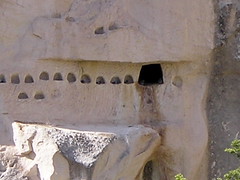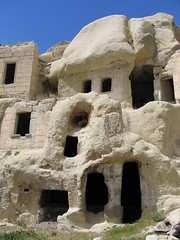
In the central steppes of modern Turkey lies an area of fascinating natural beauty and even more fascinating subterranean architecture. In Cappadoccia there are numerous dwellings, churches, and other buildings carved into the rock and built from bricks of the same.
More impressive are the underground cities, built by early Christians as places of refuge and dwelling. So far eight have been found, but there are probably more. The largest, at Derinkuyu, was accidentally discovered in 1965 when a man cleaning his house accidentally broke through a back wall and discovered a chamber, which led to more chambers, then more. at Derinkuyu there are at least eight separate levels extending down 85 meters below the surface, including chapels, a baptismal font, grain storage areas, and dwelling areas.
Geology: Obviously, the type of rock available in Cappadoccia is an important factor in enabling all of this construction. It's a particular type of tuff, which means it's compressed volcanic ash. The less-compressed areas have then been eroded, leaving solid masses of tuff that can be easily carved and excavated. It is easily cut into bricks for use aboveground or in dividing walls. Anyone looking to build a similar site should look for semi-arid areas of previous volcanic activity that will have built large columns of appropriate tuff. Even workers with relatively little previous stoneworking experience should be able to construct and expand subterranean dwellings in this material.
 Ecology:
Ecology: Although the soil itself is rather sandy, it is volcanic and nutrient-rich. In order to make it fertile, residents here carve decorative pigeon-holes into the rock faces for doves to nest in and harvest the guano, mixing it with the soil. Aboveground crops of grapes, apricots, and wheat can be dried and stored for long periods underground. If larger underground chambers were present, pigeonholes in subterranean caverns could be inhabited by bats and the resulting fertilizer used in mushroom production.
"Pigeon Holes", Uploaded by Verity Cridland on 11 Oct 08
 Defensibility: One advantage of interspersing numerous hand-carved cave dwellings honeycombed into a mountainside with entrances to a larger underground lair is that enemies won't know where the real entrances are. This would be much harder to accomplish in a harder stone such as granite. Furthermore, the ease of carving means that it's easy to construct elaborate labyrinths beneath the earth that make it difficult for trespassers to find their way in.
Defensibility: One advantage of interspersing numerous hand-carved cave dwellings honeycombed into a mountainside with entrances to a larger underground lair is that enemies won't know where the real entrances are. This would be much harder to accomplish in a harder stone such as granite. Furthermore, the ease of carving means that it's easy to construct elaborate labyrinths beneath the earth that make it difficult for trespassers to find their way in. IMG_0326", Uploaded by lesleyk on 23 Aug 05
No comments:
Post a Comment